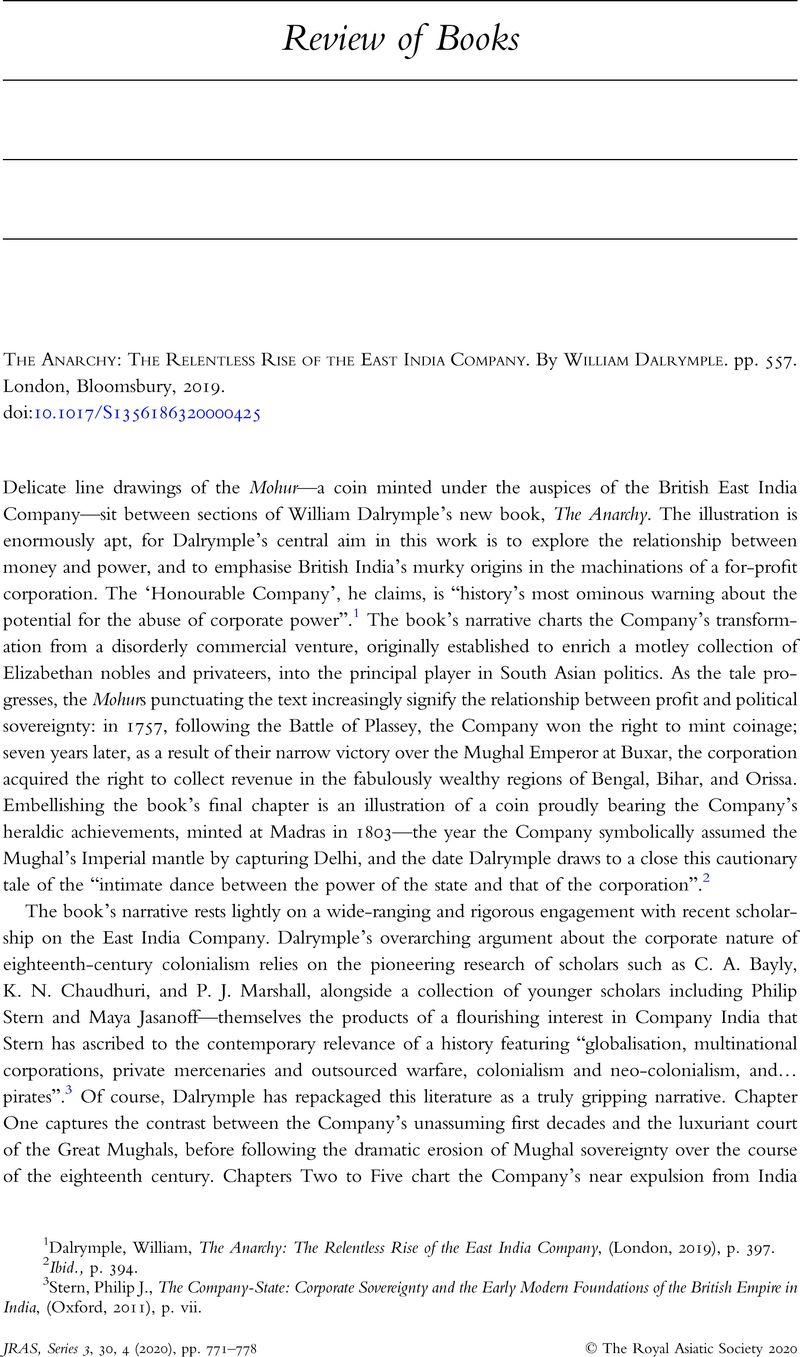No CrossRef data available.
Published online by Cambridge University Press: 17 August 2020

1 Dalrymple, William, The Anarchy: The Relentless Rise of the East India Company, (London, 2019), p. 397Google Scholar.
2 Ibid., p. 394.
3 Stern, Philip J., The Company-State: Corporate Sovereignty and the Early Modern Foundations of the British Empire in India, (Oxford, 2011), p. viiCrossRefGoogle Scholar.
4 Dalrymple, (2019), p. 40.
5 Ibid., p. xxxi.
6 Ibid., p. xxxii.
7 Ibid., p. 291.
8 Ibid., p. 31.
9 Ibid., p. 42.
10 Ibid., p. xvii.
11 Ibid., p. xxxi.
12 The ‘Aligarh School’ famously saw a brittle Mughal superstructure fragmenting as a result of pressure from below. See: Habib, Irfan, The Agrarian System of Mughal India, 1556–1707, (1963, 3rd edition, New Delhi, 2014)Google Scholar.
13 Dalrymple, (2019), p. 135.
14 Ibid., p. 394.
15 Ibid., p. 395.
16 Ibid., p. 391.
17 Wilson, Jon, The Domination of Strangers: Modern Governance in Eastern India, 1780–1835, (London, 2008)CrossRefGoogle Scholar; Stern, (2011). See also: Stern, Philip J., ‘“A Politie of Civill & Military Power”: Political Thought and the Late Seventeenth-Century Foundations of the East India Company-State’, in Journal of British Studies, Vol. 47, (April, 2008), pp. 253–283CrossRefGoogle Scholar; and Ibid., ‘Corporate Virtue: the Languages of Empire in Early Modern British Asia’, in Renaissance Studies, Vol. 26, No. 4, (2012).
18 Braddick, Michael J., State Formation in Early Modern England, c.1550–1700, (Cambridge, 2000)CrossRefGoogle Scholar; Braddick, Michael J., and Walter, John (eds.), Negotiating Power in Early Modern Society, (Cambridge, 2001)CrossRefGoogle Scholar; Brewer, John, and Hellmuth, Eckhart (eds.), Rethinking Leviathan: the Eighteenth-Century State in Britain and Germany, (Oxford, 1999)Google Scholar; Scales, Len, and Zimmer, Oliver (eds.), Power and the Nation in European History, (Cambridge, 2005)CrossRefGoogle Scholar; Shepard, Alexandra, and Withington, Phil (eds), Communities in Early Modern England, (Manchester, 2000)Google Scholar; Spruyt, Hendrik, The Sovereign State and its Competitors: An Analysis of Systems Change, (Princeton, 1994)Google Scholar.
19 Wilson, (2008).
20 Bayly, C. A., Recovering Liberties: Indian Thought in the Age of Liberalism and Empire, (Cambridge, 2011)CrossRefGoogle Scholar.
21 Young, Tom, Art in India's ‘Age of Reform’, unpublished Ph.D. thesis, University of Cambridge, 2019.
22 Dalrymple, (2019), p.341.
23 Ibid., p.xxvii.